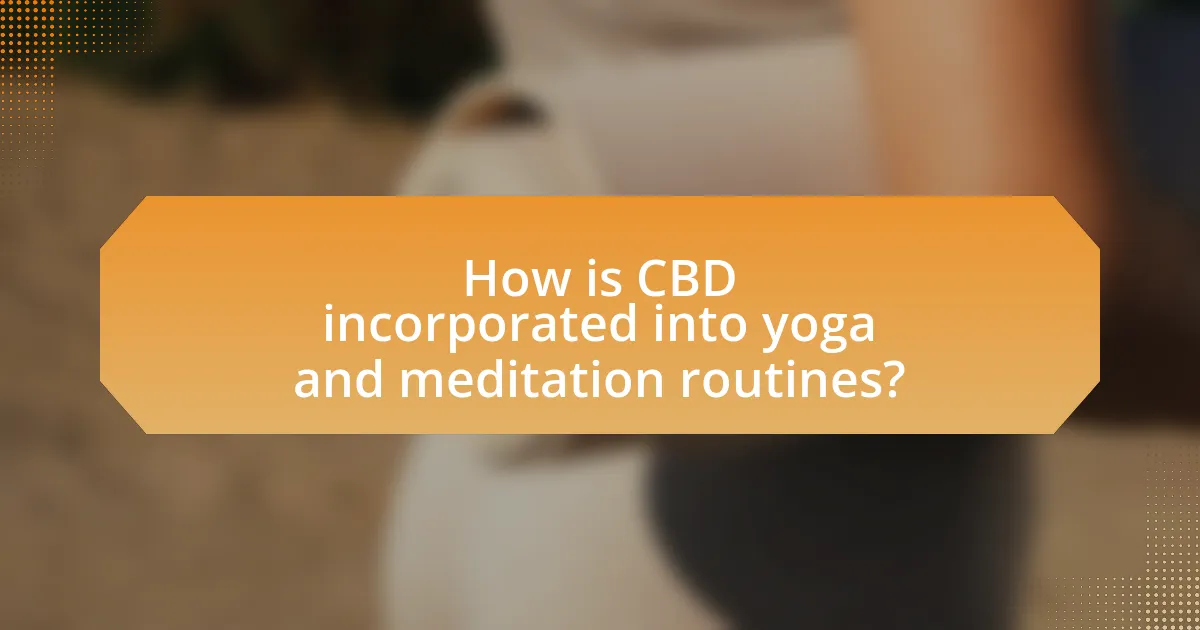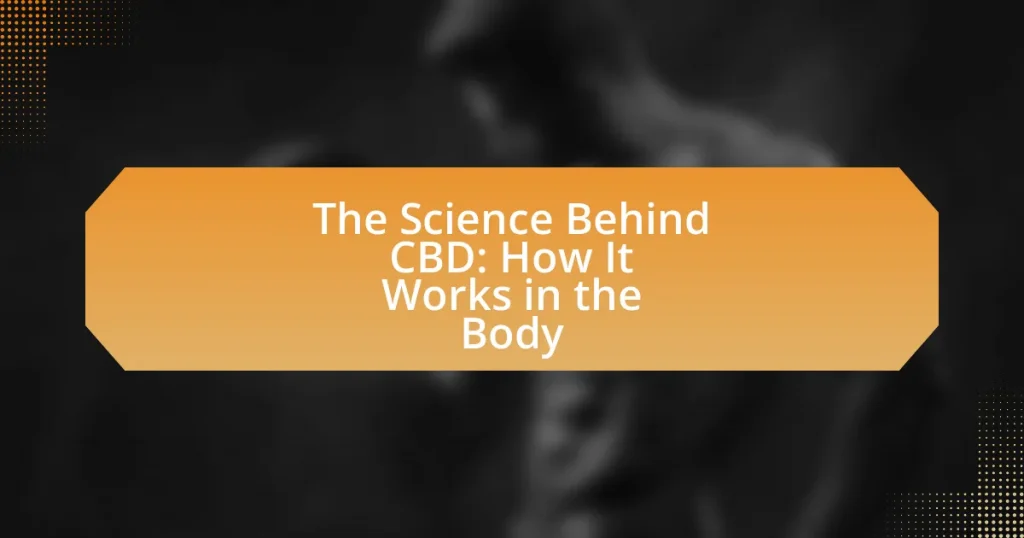The article focuses on the role of CBD in yoga and meditation practices, highlighting its potential to promote relaxation, reduce anxiety, and enhance focus. It discusses how CBD interacts with the endocannabinoid system, leading to decreased stress levels and improved mindfulness during these activities. Key topics include the physiological effects of CBD on stress and anxiety, methods of incorporating CBD into routines, recommended dosages, and considerations for product quality and legal regulations. Additionally, the article addresses potential side effects and precautions for specific populations, providing practical tips for users to enhance their experience with CBD in their wellness practices.

What is the role of CBD in yoga and meditation practices?
CBD plays a role in yoga and meditation practices by promoting relaxation and reducing anxiety, which can enhance the overall experience. Research indicates that CBD interacts with the endocannabinoid system, potentially leading to decreased stress levels and improved focus during these practices. A study published in the Journal of Psychopharmacology found that CBD can significantly reduce anxiety in participants, suggesting its effectiveness in creating a calm mental state conducive to yoga and meditation.
How does CBD interact with the body during yoga and meditation?
CBD interacts with the body during yoga and meditation primarily through its effects on the endocannabinoid system, which regulates various physiological processes including stress response, mood, and pain perception. When consumed, CBD can promote relaxation and reduce anxiety, enhancing the meditative experience and allowing for deeper focus during yoga practice. Research indicates that CBD may lower cortisol levels, a hormone associated with stress, thereby facilitating a calmer state conducive to mindfulness and physical activity. A study published in the Journal of Psychopharmacology found that CBD significantly reduced anxiety in participants, supporting its potential benefits for individuals engaging in yoga and meditation.
What are the physiological effects of CBD on stress and anxiety?
CBD has been shown to reduce physiological symptoms of stress and anxiety by interacting with the endocannabinoid system, which plays a crucial role in regulating mood and stress responses. Research indicates that CBD can lower cortisol levels, a hormone associated with stress, and enhance serotonin signaling, which is linked to mood improvement. A study published in the Journal of Psychopharmacology found that CBD administration significantly reduced anxiety in participants subjected to a public speaking test, demonstrating its potential to alleviate acute anxiety symptoms. Additionally, CBD’s anti-inflammatory properties may contribute to its calming effects, as inflammation is often linked to stress and anxiety disorders.
How does CBD influence mindfulness and focus during practice?
CBD enhances mindfulness and focus during practice by interacting with the endocannabinoid system, which regulates mood and cognitive functions. Research indicates that CBD can reduce anxiety and promote relaxation, thereby allowing individuals to concentrate better on their yoga or meditation practices. A study published in the Journal of Psychopharmacology found that CBD significantly decreased anxiety levels in participants, which can lead to improved focus and a deeper state of mindfulness during such practices.
What are the potential benefits of using CBD in these practices?
The potential benefits of using CBD in yoga and meditation practices include enhanced relaxation, reduced anxiety, and improved focus. Research indicates that CBD interacts with the endocannabinoid system, which plays a role in regulating stress and mood. A study published in the Journal of Psychopharmacology found that CBD significantly reduced anxiety levels in participants, suggesting its effectiveness in promoting a calm state conducive to meditation and yoga. Additionally, CBD may alleviate physical discomfort, allowing practitioners to engage more fully in their practices.
How can CBD enhance relaxation and recovery post-practice?
CBD can enhance relaxation and recovery post-practice by interacting with the body’s endocannabinoid system, which regulates stress and pain responses. This interaction can lead to reduced anxiety and improved mood, facilitating a more relaxed state after physical activity. Research indicates that CBD may also alleviate muscle soreness and inflammation, promoting faster recovery. A study published in the Journal of Pain Research found that CBD significantly reduced pain and improved mobility in subjects with chronic pain conditions, supporting its efficacy in post-practice recovery.
What impact does CBD have on pain management for practitioners?
CBD has a significant impact on pain management for practitioners by providing analgesic effects that can alleviate chronic pain conditions. Research indicates that CBD interacts with the endocannabinoid system, which plays a crucial role in regulating pain perception. A study published in the Journal of Pain Research found that CBD reduced pain and improved sleep in patients with chronic pain conditions, demonstrating its potential as a therapeutic option. Additionally, practitioners report that incorporating CBD into treatment plans can enhance the overall effectiveness of pain management strategies, particularly in conjunction with holistic practices like yoga and meditation.

How is CBD incorporated into yoga and meditation routines?
CBD is incorporated into yoga and meditation routines primarily through the use of CBD-infused oils, edibles, or topical applications that enhance relaxation and focus. Practitioners often consume CBD before or during sessions to alleviate anxiety, reduce stress, and improve overall mindfulness. Research indicates that CBD may interact with the endocannabinoid system, potentially promoting a sense of calm and enhancing the meditative experience. For instance, a study published in the Journal of Psychopharmacology found that CBD can significantly reduce anxiety levels, which supports its use in practices aimed at mental clarity and emotional balance.
What forms of CBD are commonly used in these practices?
Common forms of CBD used in yoga and meditation practices include CBD oils, tinctures, capsules, edibles, and topical creams. CBD oils and tinctures are favored for their quick absorption and ease of use, allowing practitioners to incorporate them into their routines seamlessly. Capsules and edibles provide a convenient option for those seeking longer-lasting effects, while topical creams are applied directly to the skin for localized relief. These forms are popular due to their varying methods of consumption, catering to individual preferences and enhancing the overall experience of relaxation and mindfulness associated with yoga and meditation.
How do oils, edibles, and topicals differ in their application?
Oils, edibles, and topicals differ in their application primarily through their method of delivery and onset of effects. Oils are typically administered sublingually, allowing for rapid absorption into the bloodstream, which can lead to quicker effects within 15 to 30 minutes. Edibles, on the other hand, are ingested and metabolized through the digestive system, resulting in a delayed onset of effects that can take 30 minutes to 2 hours, but often provide longer-lasting relief. Topicals are applied directly to the skin, targeting localized areas without entering the bloodstream, making them ideal for localized pain relief or skin conditions. This distinction in application methods influences the timing and area of effect for each form of CBD.
What is the recommended dosage for practitioners?
The recommended dosage of CBD for practitioners typically ranges from 10 to 30 mg per day, depending on individual factors such as body weight, metabolism, and the specific effects desired. Research indicates that starting with a lower dose and gradually increasing it allows practitioners to find the optimal amount for their needs, as noted in a study published in the journal “Cannabis and Cannabinoid Research” by Dr. Ethan Russo, which emphasizes the importance of personalized dosing in achieving therapeutic benefits.
What are the best practices for integrating CBD into sessions?
The best practices for integrating CBD into sessions include starting with a low dosage, ensuring quality and lab-tested products, and timing the administration appropriately. Starting with a low dosage allows individuals to assess their tolerance and effects, which is crucial for personalizing the experience. Using high-quality, lab-tested CBD products ensures safety and efficacy, as these products are verified for purity and potency. Timing is also essential; consuming CBD approximately 30 to 60 minutes before a session can enhance relaxation and focus, aligning with the goals of yoga and meditation practices. These practices are supported by anecdotal evidence from users who report improved mindfulness and reduced anxiety when incorporating CBD into their routines.
How can practitioners ensure a safe and effective experience?
Practitioners can ensure a safe and effective experience by conducting thorough assessments of individual needs and potential contraindications before integrating CBD into yoga and meditation practices. This includes evaluating the participant’s medical history, current medications, and any known allergies to cannabinoids. Research indicates that CBD can interact with certain medications, such as blood thinners, which underscores the importance of this assessment (National Institutes of Health, 2020). Additionally, practitioners should start with low doses of CBD and monitor participants’ responses, adjusting as necessary to optimize comfort and effectiveness. Providing clear information about the source and quality of CBD products used can further enhance safety, as products vary widely in purity and potency.
What should be considered when choosing a CBD product?
When choosing a CBD product, it is essential to consider the product’s source, potency, and third-party testing. The source of the CBD determines its quality; products derived from organically grown hemp are generally more reliable. Potency is crucial as it indicates the concentration of CBD, which can affect its efficacy; consumers should select a potency that aligns with their individual needs. Third-party testing provides transparency and assurance of the product’s purity and safety, confirming that it contains the stated amount of CBD and is free from harmful contaminants. Research indicates that products with clear labeling and certification from independent labs are more trustworthy, enhancing consumer confidence in their choices.

What are the challenges and considerations of using CBD in yoga and meditation?
The challenges and considerations of using CBD in yoga and meditation include potential legal issues, dosage variability, and individual reactions to CBD. Legal regulations surrounding CBD vary by region, which can complicate its use in public classes or studios. Additionally, the lack of standardized dosing can lead to inconsistent effects, making it difficult for practitioners to determine the appropriate amount for their needs. Individual responses to CBD can also differ significantly; some may experience relaxation, while others might feel anxious or lethargic, impacting their practice. These factors necessitate careful consideration and personal experimentation to ensure a beneficial experience.
What legal and regulatory issues surround CBD use?
The legal and regulatory issues surrounding CBD use primarily involve its classification, safety regulations, and state versus federal laws. CBD is derived from hemp, which was legalized under the 2018 Farm Bill in the United States, provided it contains less than 0.3% THC. However, the FDA has not approved CBD for food or dietary supplements, leading to uncertainty in its commercial use. Additionally, individual states have their own regulations, which can vary significantly; some states allow CBD in food and beverages, while others do not. This patchwork of laws creates challenges for consumers and businesses alike, as compliance can be complex and inconsistent across jurisdictions.
How do varying laws affect practitioners in different regions?
Varying laws significantly impact practitioners of CBD in yoga and meditation across different regions by determining the legality of CBD use, which influences their practices and client interactions. For instance, in the United States, the 2018 Farm Bill legalized hemp-derived CBD, allowing practitioners in states that have adopted this law to incorporate CBD into their offerings legally. Conversely, in regions where CBD remains illegal or heavily regulated, such as certain countries in Europe and Asia, practitioners face legal risks and limitations in their ability to use or recommend CBD, which can hinder their practice and client engagement. This legal landscape directly affects the availability of CBD products, the willingness of practitioners to integrate CBD into their sessions, and the overall acceptance of CBD within the wellness community.
What should practitioners know about product quality and sourcing?
Practitioners should understand that product quality and sourcing are critical for ensuring the efficacy and safety of CBD products used in yoga and meditation practices. High-quality CBD products should be sourced from reputable suppliers who provide third-party lab testing results, confirming the cannabinoid content and absence of harmful contaminants. According to a study published in the Journal of the American Medical Association, nearly 70% of CBD products tested were inaccurately labeled, highlighting the importance of sourcing from transparent manufacturers. Additionally, practitioners should be aware of the extraction methods used, as CO2 extraction is considered the gold standard for producing pure and potent CBD oil.
What are the potential side effects of using CBD during practice?
The potential side effects of using CBD during practice include fatigue, changes in appetite, diarrhea, and potential interactions with other medications. Research indicates that CBD can cause drowsiness in some individuals, which may affect performance during yoga or meditation. Additionally, some users report gastrointestinal issues, such as diarrhea, which can disrupt practice. A study published in the journal Cannabis and Cannabinoid Research highlights that while CBD is generally well-tolerated, it can interact with certain medications, leading to altered effects. Therefore, individuals should consider these potential side effects when incorporating CBD into their practice.
How can users identify and manage adverse reactions?
Users can identify and manage adverse reactions by closely monitoring their physical and mental responses after using CBD during yoga and meditation. This involves keeping a detailed journal of any side effects experienced, such as dizziness, fatigue, or changes in mood, which can help in recognizing patterns and triggers. Additionally, consulting with healthcare professionals can provide guidance on appropriate dosages and potential interactions with other medications, ensuring a safer experience. Research indicates that a systematic approach to tracking reactions can significantly enhance user safety and satisfaction, as evidenced by studies showing that informed users report fewer adverse effects.
What precautions should be taken for specific populations?
Specific populations, such as pregnant women, individuals with liver disease, and those taking certain medications, should take precautions when using CBD in yoga and meditation practices. Pregnant women are advised to avoid CBD due to potential risks to fetal development, as studies indicate that cannabinoids can cross the placenta and affect the developing fetus. Individuals with liver disease should consult healthcare providers before using CBD, as it may alter liver enzyme activity, impacting drug metabolism. Furthermore, those on medications like blood thinners should be cautious, as CBD can interact with these drugs, potentially increasing the risk of bleeding. These precautions are essential to ensure safety and minimize adverse effects associated with CBD use.
What practical tips can enhance the experience of using CBD in yoga and meditation?
To enhance the experience of using CBD in yoga and meditation, individuals should consider starting with a low dosage of CBD oil or edibles to assess their body’s response. Gradually increasing the dosage allows for a tailored experience that aligns with personal comfort levels. Additionally, incorporating CBD into a pre-session routine, such as taking it 30 minutes before practice, can help maximize its calming effects during yoga and meditation. Research indicates that CBD may reduce anxiety and improve focus, which can enhance mindfulness practices. Furthermore, choosing high-quality, lab-tested CBD products ensures safety and efficacy, contributing to a more positive experience.



